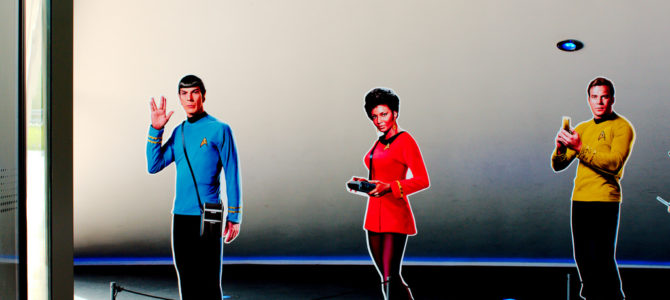
It has become commonplace to lament that we don’t have a common culture any more—a repertoire of art that we can all enjoy regardless of our political loyalties. Well, maybe it’s because we have a lot of people trying to mark off parts of the culture as their tribal territory, off-limits to partisan enemies.
I thought of this when someone sent me a link to a recent podcast for science-fiction fans, in which political commenter Ana Marie Cox puzzles over the fact that Ted Cruz is a big Star Trek fan. (To save you some trouble, it’s about 28 minutes in.) Why is this such a mystery? “The original Star Trek universe, for its time even, was pretty social justice warrior-y.”
Try not to spit out your coffee. To paraphrase Dr. Carol Marcus, Jim Kirk was many things, but he was never a social justice warrior.
Cox is partly just trying to flog her own science-fiction column, which features, from what I can tell here, ridiculous political over-analysis of pop-culture sci-fi. But this also reflects how PC didacticism is becoming the mainstream culture’s official theory of art, a topic I’ve been railing about a lot recently. Certainly, if you watch Star Trek and your main takeaway is that it’s a good advertisement for lefty politics—because, as the podcast host puts it, “there’s no money, and everybody’s super-liberal”—you’re really missing the point.
Primarily, though, I see this as a giant demonstration of Jonathan Haidt’s point about how people on the Left generally make no effort to understand those of us on the Right. Haidt and two other psychologists, Jesse Graham and Brian Nosek, conducted a famous experiment in which they asked conservatives to answer a questionnaire as if they were liberals and asked liberals to answer as if they were conservatives.
The result is not a mystery to anyone on the Right. We understand the Left’s perspective pretty well, because how could we avoid it? It has been broadcast to us every day for most of our lives, in school, in the movies, on social media, and so on. But liberals trying to answer as conservatives consistently got it wrong. Unwilling to consider why anyone would honestly oppose the welfare state, for example, they assume that people on the Right just hate the poor. Trapped in their own cultural bubble, people on the Left regard their politics as the blandly normal, default view of all decent people, while turning any opposing view into a cartoon caricature of evil.
You can see this in Cox’s surprise that Cruz would embrace Star Trek, because “it’s a post-scarcity world with lots of different [skin] colors, lots of different nationalities”—though she avers that if you look hard enough, “I think we could find in it—like, obviously there’s patriarchy and white hegemony,” so maybe that’s what Cruz sees in it.
Got that? Conservatives are obviously against racial diversity, in favor of keeping people poor, want to keep women in the kitchen, and want white people to always be in charge of everything. This is like Tom Lehrer’s parody of the flattering self-image of the hippies’ “Folk Song Army“: “we all hate poverty, war, and injustice—unlike the rest of you squares.”
Perhaps Cox’s prejudice on this subject is exacerbated by the election of Donald Trump, whose railing against Mexican immigrants and soft-pedaling on white nationalists seems to confirm her caricature. This has certainly unhinged a lot of people on the Left, helping them convince themselves that anyone to their right is Snidely Whiplash.
But Cox has been around politics long enough to know better. She has certainly been around long enough to remember the Benetton ad that was the 2016 Marco Rubio campaign. (And the person who made that comparison? Nikki Haley, now a member of the Trump administration.) Yet she sees a science-fiction franchise with enlightened, humanistic values and assumes that nobody who votes differently from her could possibly like it.
That brings us back to the didacticism of current mainstream criticism. Making art all about a narrow political agenda will cause you to miss the more important things that are going on. It will definitely cause you to miss how others see it.
For example, something many of us on the Right appreciate about the multiracial crew of Star Trek is that race is no longer an issue. Nobody talks about it, nobody argues about it. Geordi La Forge is not hailed for being the first black chief engineer of a Galaxy-class starship. Nobody complains that Jean-Luc Picard shouldn’t have gotten his command because that perpetuates the “patriarchy” or “white hegemony”—though such complaints clearly have a lot of purchase with today’s Left. The Star Trek universe is a meritocratic, “color blind” society, which is what a lot of us on the Right regard as the ideal.
In effect, Star Trek projects into the twenty-third century (and beyond) the final end point that is missing from the current racial politics of the Left. Wasn’t that the point of “Let That Be Your Last Battlefield,” the 1969 episode that used a science-fiction premise for a not-so-subtle commentary on civil rights and racism? The point wasn’t just that racism is irrational. It was a stand against unending racial conflict and the inability to find common ground in our shared humanity. So that’s a message in Star Trek that a lot of us see: that we are not doomed to a future of endless grievance and reprisal.
Then, of course, there is James Tiberius Kirk, an icon of American individualism. This was particularly true after Star Trek II: The Wrath of Khan, the real foundation for the whole franchise. (It was Star Trek’s last chance to perform at the box office, and from its success, all the subsequent movies and TV shows followed.)
That film was specifically designed to look back to the original series and extract the essence of what people loved about it. So it gave us Kirk’s unique solution to the Kobayashi Maru Test and his conspicuous impatience with paperwork and bureaucracy and doing things “by the book.” Does he sound like a guy with a lot of patience for PC posturing? No, he does not, which is probably why William Shatner himself has since been denounced as alt-right—a ridiculous claim—for the sin of criticizing online “social justice warriors.”
I’ve been warning against PC art, but I am not saying that art should never take on political themes. Art becomes didactic when it is considered valuable for its political theme alone, overshadowing everything else, as if having the right message is the only thing that is important. Good art can definitely have a political message, but it is integrated into a good story, ingenious plot structure, interesting characters, thoughtful meditations on life, and so on. This gives it a meaning and appeal far beyond the narrow circle of those who agree with its politics.
There are plenty of examples. Giuseppe Verdi was an ardent advocate of Italian unification, and the Risorgimento was a theme that motivated some of his early operas. But they are still performed to eager audiences today, more than century after that ceased to be an active cause, because there is so much else to hear in them.
That’s also true of Star Trek, which spent most of its time on themes that had nothing directly to do with politics. The character of Spock, for example, was the series’ way of exploring the issue of reason versus emotion. My favorite Star Trek episode is the “Next Generation” entry “Darmok,” a high-concept adventure that explores the nature of language and asks how much you would risk to allow two peoples to communicate with one another. Patrick Stewart’s favorite episode is from the same season: “The Inner Light,” a haunting meditation on mortality and what we leave behind us when we’re gone.
Against that, what is the case that Star Trek is only for the Left? A couple of episodes with crackpot ideas about money?
One of the hallmarks of good art is that it can have many fans who don’t agree with its specific political solutions. Take Ayn Rand, who occasionally let political themes creep into her novels. Yet if you are a Rand fan like me, you hear pretty frequently about some famous person or Hollywood star who you would never in a million years peg as a staunch right-winger, who nevertheless turns out to be a Rand fan.
The Fountainhead may be an attack on collectivism in which the central villain is a socialist, but it is also a tribute to creativity and artistic integrity in the face of conformism. That’s a theme with wide appeal, which many people in Hollywood would certainly like to tell themselves they agree with. But here you’ll find Mother Jones getting the vapors about the existence of Hollywood Ayn Rand fans. After all, the arts is a domain they have marked out as being owned by the Left, so authors from the Right are not to be permitted.
It all fits together. If nobody can read and enjoy Rand unless they sign to her entire political agenda, then it stands to reason that nobody on the Right is allowed to play in the progressive sandbox of Star Trek fandom.
This is a good way to enforce tribal dividing lines. It’s also a good way to make our understanding of art militantly superficial and keep us from appreciating its most profound and universal meaning.
Robert Tracinski is a senior writer for The Federalist. His work can also be found at The Tracinski Letter.









